Concert Review
Sacramento Choral Society & Orchestra
Wells Fargo Home for the Holidays - December 9, 2017
For 22 years, the Sacramento Choral Society & Orchestra (even before there was an “& Orchestra” in the name) has offered a celebratory Christmas concert to the Sacramento community. With the sponsorship of Wells Fargo in recent years and growing audiences, it is now held in the Sacramento Memorial Auditorium as “Wells Fargo Home for the Holidays” in two performances that this year drew a cumulative audience of 3,500. I attended the afternoon installment of the two performances to be held on this day.
The event began with SCSO Board President James McCormick welcoming us and giving a little history of the Memorial Auditorium. He noted that the venue was dedicated to veterans, and he went on to announce that this concert would be dedicated to veterans (many of whom were special guests), as well as to all those around the world who are striving for peace. He added that the event was staged by the SCSO in partnership with television station KVIE and the Make-A-Wish Foundation (about which more later). He made a special point of thanking sponsor Wells Fargo & Company, pointing out company's extraordinary support of nonprofit organizations, and asking us to register our thanks to them by applause — which we gladly did.
Sacramento Memorial Auditorium is cavernous, with a 50-foot ceiling over the main floor, surrounded by 2 ranks of balconies on 3 sides. I was fortunate to have a seat in the first balcony on the left side of this vast room. I say “fortunate” because the view was magnificent: one could see the entire orchestra and chorus, plus the conductor, whatever was happening at the front of the stage — and throughout the entire Auditorium, for that matter. The problem was that the descent to one's seat was steep, the steps narrow, and the seats themselves were narrow — a tight fit for me and, I imagine, anyone who is more than 20% over their ideal weight as defined by the Centers for Disease Control.
McCormick initiated the performance by introducing Concertmaster Cindy Lee, and with the entrance of Conductor Donald Kendrick, a truly grand celebration of the Christmas holiday was underway.
(Click here to open the program in a new window.)
While McCormick was speaking, singers had been assembling in the passageways above the second balcony on all 3 sides of the Auditorium. At Kendrick's direction, the lights went down, there was a chiming of bells, and the singers brought out light sticks: green for the SCSO chorus and white for the Sacramento Children's Chorus Crescendo ensemble, who were appearing tonight with their new Director, Alexander Grambow. Crescendo was the first to sing — from their position above the balconies and opposite the stage. The piece was “Sing We Noel!” (written by Kendrick), and it was performed a cappella and flawlessly to my ear. Then there was a trumpet solo, and we heard “Personent Hodie” from the SCSO singers. They were spread to all the extremities of the Auditorium, and apart from the novelty of having people singing behind me and my fellow audience members, the remarkable thing in this performance was how unified the sound was, despite some singers being 80 feet or more from each other or from the conductor. The effect was glorious with the voices filling the space, and the chorus well-balanced with the orchestra.
The next piece was orchestral, Leroy Anderson's “A Christmas Festival,” and it was far more than mere cover for the chorus members to move from the nether reaches of the Auditorium to their places on the risers. That activity was itself rather impressive: singers in procession (children first) down the two central aisles, light sticks still glowing prominently in the dark, and it was a dramatic illustration of the number of singers in this event (157, according to the program). But what was wonderful about this part of the program was the music, festive and varied — a traditional, satisfying arrangement of traditional Christmas carols. Kendrick directed with unabashed enthusiasm, giving all principal cues and leading the players to a truly grand finale. The orchestra stood at the end to acknowledge the applause and cheers of the audience.
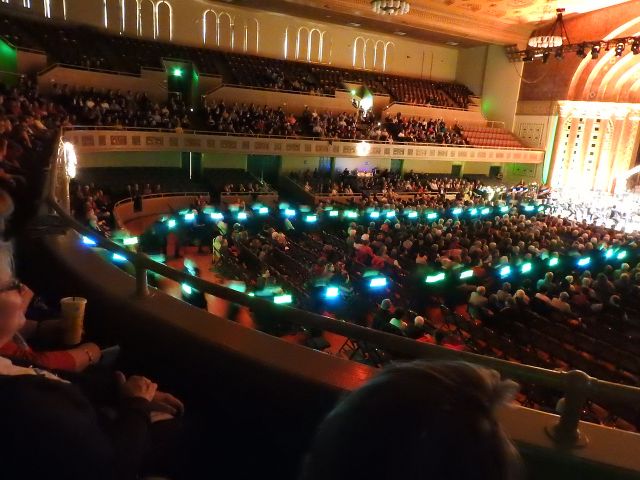 |
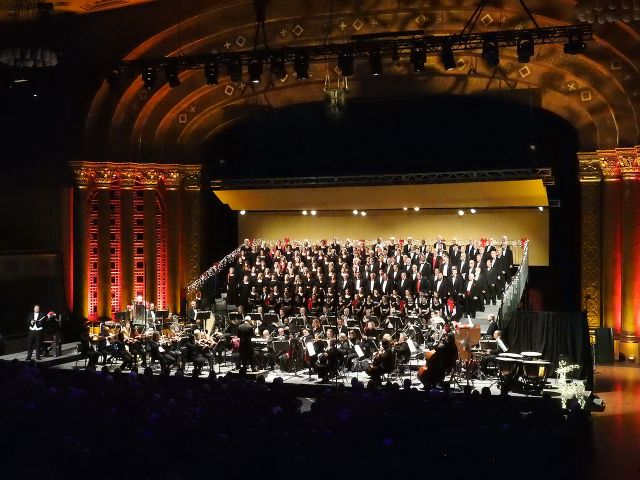 |
| The Procession | All performers on stage |
At this point, Kendrick spoke to us, previewing the next few pieces and noting SCSO's partnering with the Make-A-Wish Foundation. He added that SCSO had heard of 20-year-old “Anna,” a student at the University of the Pacific in Stockton, whose wish was to play with a professional symphony orchestra. Wish granted! To the warm applause of the audience, she came to the stage with her cello and took the place made for her in that section of the orchestra.
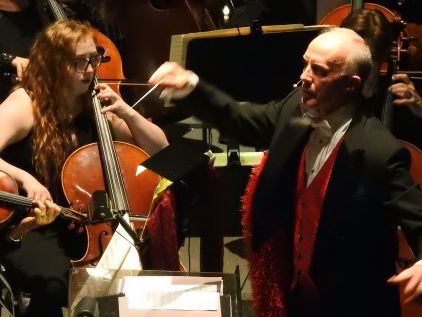 |
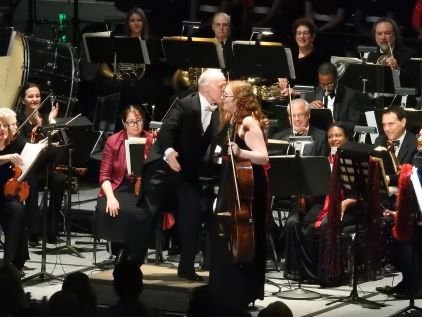 |
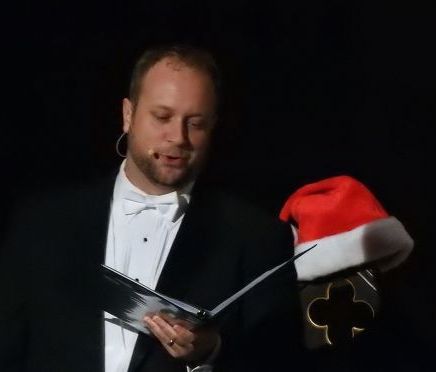 |
| Anna and Donald Kendrick | After Anna's performance | Matt Hanscom |
As “Do You Hear What I Hear?” began, I found myself reflecting what an extraordinary opportunity this concert was: to hear this holiday music accompanied by the incredibly rich sounds of a full orchestra. With the chorus still in good balance with the orchestra and producing beautiful harmonies on their own, the piece built to a rousing climax. Her wish fulfilled (except for another opportunity later in the program), Anna left the stage, but not before acknowledging the extra applause from the audience and getting a hug of encouragement from Conductor Kendrick.
The Crescendo ensemble then performed “Magical Kingdom” by John Rutter. It was a charming piece, to be sure. But it was too dark to follow the lyrics in the program, and Crescendo's youthful singing was pure but light, even despite the minimal orchestration. So it was hard to fully appreciate this performance, which could have benefited from a bit more sound amplification. With their bigger voices and greater number, the SCSO's articulation of the lyrics of the “Sussex Carol” was clear. In my notes, I observed: “Each song is really thrilling.”
After Kendrick introduced the next section of the program and guest soloist Matt Hanscom, the latter performed “It Wouldn't Be Christmas Without You,” accompanied by the chorus. “Jingle Bells” was next on the program, but it was nothing like what you might have expected. That familiar old song had a new and interesting rhythm and was delivered with an even higher level of energy than “Jingle Bells” usually gets. While it was being performed, I noticed the scattering of Santa hats around the orchestra: sitting on top of one of the bass violins, perching on the harp, the chimes, and the soloist's chair — and adorning the heads of a few of the performers. Just a few of the many touches that contributed to the festive nature of this performance.
 |
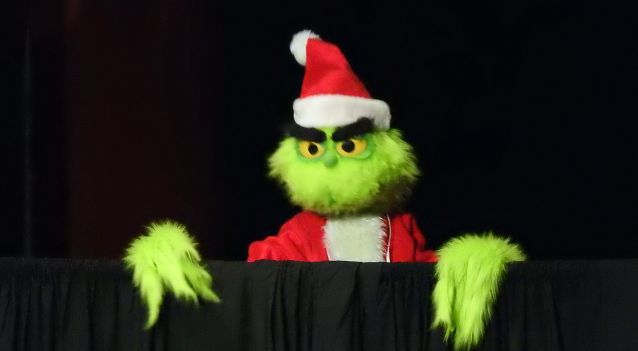 |
| Sacramento Children's Chorus - Crescendo | The Grinch |
In a concert full of highlights, “The Grinch Medley” topped them all. It consisted of three songs from the animated version of How the Grinch Stole Christmas, all linked together by a narrated adaption of the original book. Matt Hanscom performed the narration, and in the process I found myself awed by the talent he brought to his dramatic reading, giving voices to the characters (the Grinch voice was brilliant), and making the most of the drama in this charming story. But Hanscom wasn't really the focus of the audience’s attention. That was reserved for a puppet theater at stage left. The “theater” was essentially a black box, made of cloth suspended from pipes, 7 feet high and about 6 feet in width and depth. At the top appeared the puppets of the Green Valley Theatre Company: the green Grinch, his dog (dressed like a reindeer), and a number of tiny residents of Whoville. The Grinch was wonderfully expressive, especially his fingers — with the quality of the Muppets and reminiscent of Oscar the Grouch. He (and the other puppets) responded to all the details of Hanscom's reading, and it was difficult to turn away from them. Of course, there was music in this medley, songs familiar from the animated version of the story. But the highlight was Hanscom's over-the-top singing of “You're a Mean One, Mr. Grinch.” All I can add is that every element of the performance of the medley added up to sheer delight.
The first half of the program concluded with a glorious “Gloria” by Randol Alan Bass. Overall, the piece had contemporary harmonies and rhythms, but with gentle melodic sections as well, and even a short section of a cappella singing. It was fast-moving, and had a holiday feeling to it.
The joy Donald Kendrick took in every aspect of this program helped me to understand why directors are famously so long-lived. Whether the music is exuberant, lulling or even partaking of any others of the wide range of human emotions, it embodies harmony or at least meaningful structure. And immersing one's life in the extraordinary variety of musical expression, and teaching and coordinating people in its performance has to be one of the most joy-inducing, self-fulfilling and life-affirming endeavors imaginable.
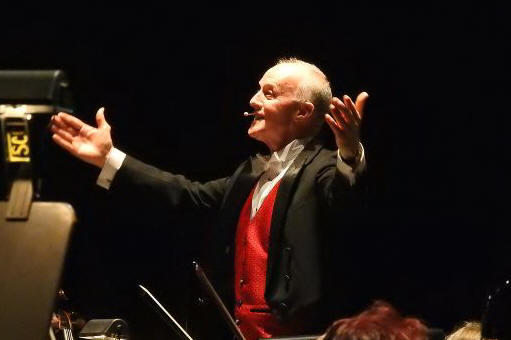 |
||
| Director Donald Kendrick |
Kendrick began the second half by getting us all to stand up and sing. It was a 6-part medley with orchestral accompaniment, so there are now thousands more people who can say they sang with the Sacramento Choral Society & Orchestra. I’m sure that everyone enjoyed this audience-participation interlude immensely. I certainly did.
“Still, Still, Still” was a gentle, beautiful arrangement of a song that has become a Christmas standard. As I listened, I found myself reflecting on the many children in the audience. What a great experience for them to hear a full professional orchestra playing (and excellent adult and children’s choruses singing) sophisticated music. I bet it changed the course of the lives of many children on this day.
Next on the program was a presentation of “The Night Before Christmas.” Matt Hanscom read this classic poem with the same dramatic flair we had heard in “The Grinch Medley.” The music was a contemporary orchestral interpretation of the poem. It was composed by Randol Alan Bass, and his music brilliantly followed the imagery of the poem. For example, I noticed that the line “while visions of sugar plums danced in their heads” was accompanied by the briefest snatch of “The Dance of the Sugar Plum Fairy” from Tchaikovsky’s The Nutcracker. Making these subtleties work required careful attention on the part of Hanscom, who read not only with wonderful expressiveness, but without hesitation or errors — and ending with a big smile.
The Sacramento Children’s Chorus Crescendo ensemble next took the stage to perform “Christmas Morning.” Once again, I could only make out a few of the words (see the program and you’ll understand why). It was a cute, joyful, fast-paced song, and the kids were full of life as they performed it. I found it charming that some could not quite keep still as they sang.
We had a return visit from Anna to help perform “Christmas Lullaby.” As its sweet music filled the air, I noticed that Anna was a serious student of the cello, consistently using “finger vibrato” as she played.
I’m not sure that the next guest was quite as serious a student of music. Kendrick announced that another Make-A-Wish client had expressed the desire to conduct an orchestra. With that, 10-year-old Grayson came out to join Kendrick at the podium. Kendrick explained that if he were to lead the orchestra, he would need the “magic baton.” And to prove his point, he invited Grayson to try to lead the orchestra without it. He did so, and the players generated a wonderful, outrageous cacophony for about 10 seconds — as much as any of us could stand.
Now it was time for the real thing, conducting the orchestra in Leroy Anderson’s “Sleigh Ride.” In a cute gesture, Grayson tapped the baton on the music stand in front of him and began directing. The tempo is “allegro con ritmo” — fast or lively, with rhythm. But Grayson was too excited to observe the specified rhythm, and he waved the baton as fast as he could for the duration of the piece. The orchestra must have been ready for this because they played the well-loved piece perfectly at the proper tempo. At the conclusion of his conducting debut, Grayson exchanged a high-five with Kendrick, and the youngster walked off with what appeared to me as a great sense of satisfaction.
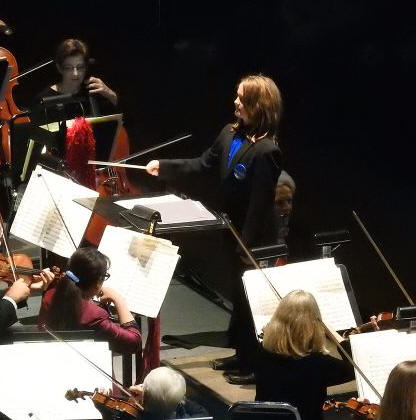 |
 |
| Grayson directing | Alex Grambow, Matt Hanscom,
Grayson, Anna, Donald Kendrick & Wells Fargo President David Galasso (and daughter Grace) |
I was glad to see in “Holiday Greetings” a recognition of a variety of holiday traditions: Christmas, Chanukah, Kwanzaa, and even little-known celebrations in several other parts of the world. Kendrick spoke at the conclusion of this piece, noting that he had led 22 years of these Christmas concerts. He added that he was retiring from directing choral activities at Sac State, and there was an immediate collective groan of disappointment from the audience — until he clarified that his retirement would only be from teaching, not from SCSO. He thanked Wells Fargo again for their sponsorship and concluded with inspiring words that I wish I had somehow been able to record.
Then all the singers joined with Matt Hanscom for “It’s the Most Wonderful Time of the Year” followed by a traditional arrangement of “Silent Night” that had many people around me softly singing along. The final piece, “We Wish You a Merry Christmas” brought out the Green Valley Theatre Company puppets, and soon all the evening’s performers were on the stage for bows that were prolonged by an enthusiastic, grateful audience.